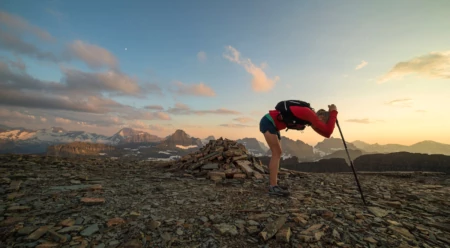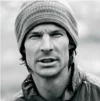Nose to the Wind
Steve House joins forces with coach Scott Johnston and athlete Kílian Jornet to develop a comprehensive approach to finding the joy and the payoff of intense training. Even lunges.
The wind had made its presence known all night, the tiny tent shaking off its layer of breath-turned-frost with each gust. The icy flakes settled, then melted onto the only part of me sticking out of the sleeping bag: my nose. I was tired when I woke, but no more than Marko, whom I followed out the tent door at dawn. We snapped on crampons, shouldered our summit packs and climbed into the storm.
All our known world was below us, invisible but pulling on us like gravity. Marko climbed steadily, quickly; I, more slowly and erratically. Soon he was also invisible to me somewhere above. The loneliness of being lost in between my partner and my world was crushing. I sped up for a moment then stumbled, gasping, coughing and wheezing. With only footprints in the snow—no one had ever passed here before (or since)—and the occasional parting of cloud to reveal Marko’s green jacket, the mark of an alien in the black-and-white world of 23,000 feet in the Himalaya, I could see enough to know he was there. I could follow, but I couldn’t keep up.
Two hours later we turned around, our summit attempt abandoned after five hard-fought days of climbing. A lifetime goal became the newest addition to the dusty, cluttered shelf of abandoned dreams.
I’d climbed thousands of mountains, and I’d never trained. I’d earned sponsorships and attention and money as a climber. And I’d never trained. I’d outpaced partners, put up first ascents, gone 60 hours up the steepest, iciest wall in North America. And I’d never trained. Now I had to turn around on the biggest, highest, hardest mountain I’d ever attempted—because I had never trained.
When I came home I found a coach and started training. Six months later I was sick, IVs in my veins, fever on my brow. I didn’t eat for 21 days and went from 165 pounds to 135 pounds. Once I started to come around, Scott Johnston, my friend and climbing partner, and a former World Cup cross-country ski racer, called me over to his house and cooked a hamburger.
Sitting it in front of me, he said, “You know why you got sick, right? She [your coach] doesn’t understand climbing; she doesn’t understand what goes into your job. She overtrained you. Badly. You have to layer training volume on gradually.”
So began my first of thousands of lessons on endurance training and physiology, lessons that eventually would become our first book together, Training for the New Alpinism. Needless to say, Scott became my coach. My fitness blossomed. Less than two years later, I turned pro climber—no other work. My climbing career went worldclass, and I never found myself overtrained, ill or injured again. Until I fell 100 feet from a mountain in Canada.
I like to say that the only people who are not enthusiastic about training are those who haven’t trained correctly. The only people who hate lunges are those who’ve never done enough of them to experience what strong legs feel like on the trail. The only ones who hate long, slow aerobic capacity–building runs and skis are those who have never known what it feels like to sail up the mountain, nose to the wind, with ease. Relaxed, poised, moving fast and flying.
The fitness world is a minefield of snake oil salesmen, fads and claims that are too good to be true that are just that. While I recovered from my fall, healing dozens of fractures, punctured lungs and a shaken identity, Scott and I began to try to answer the most common question I got as a professional climber: How do you train? When we published Training for the New Alpinism in 2014, its success far exceeded our expectations. We’d figured on enough alpinists to sell maybe 1,000 copies. We sold 50,000.
Eventually we learned that we had been right. Fifty thousand alpinists did not buy our book. Ten thousand did, with the other 40,000 copies going to mountain runners, ski mountaineers and skimo racers who lacked a training guide of their own and decided alpinism was the closest thing.
I met Kílian Jornet in my home mountains in early winter of 2014. He and Emelie Forsberg were there to ski some of the famous Colorado powder. We teamed up, and I guided them to a classic steep descent near Telluride—the San Joaquin Couloir. We skinned from the valley at the first December light, scrambled up the shoulder and were back in the valley before noon. At the bakery, we ate muffins, our first food of the day, and Kílian told me how much he’d enjoyed Training for the New Alpinism. I told him how surprised we’d been by the response and adoption of the book by so many mountain athletes.
“Yes,” he said. “There’s nothing like it for us.” “We should write that book together!” I almost shouted. Kílian had told me about his university studies in exercise physiology earlier that morning while we were skinning.
Kílian demurred. “I don’t want to write,” he said, then excused himself to do another workout, steep Zone 3 intervals.
On the drive home I called Scott, and a plan was born. In June 2015, at the 14,000-foot camp on Denali, I shared our progress with Kílian. That August, with an outline, a publishing agreement and a lot of emails, Kílian and I met again, this time in Zermatt, Switzerland. We squeezed in some peak bagging—nothing technical. Fortunately for me, fresh snow blanketed the Alps at that time; I had the impossible task of trying to keep up with Kílian on steep trails and ridges. We spent three rainy days camped in my van, frying up big pans of rösti (Swiss potatoes and cheese) and discussing the book, training techniques and their relative value, training mistakes, how to organize and present so much information, and more. Our only problem was parking the van someplace acceptable to the Swiss.
Armed with Kílian’s insights, Scott wrote and shared drafts with the two of us. Our network of advisors grew: Luke Nelson and Mike Foote joined as trusted “reviewers.” Both Luke and Mike confirmed that when it comes to endurance athletes, high-intensity interval training (HIIT) programs pushed by journalists who are not coaches, while useful at times, should be used as a supplement to—and not a substitute for—aerobic base training.
Luke, with his well-laid foundation of over a decade of long runs, progressed magically with weighted hill climbs, long one of our secret weapon workouts. Luke would select a weight that made the fatigue in his legs, not his breathing, the speed limiter. He’d start a cycle of these carrying over 50 pounds, a very heavy pack and many gallons of water sloshing around as he would hike up a steep fall-line trail, going as hard as he could maintain for an hour. Then he’d carefully work his way back down with the weight, reset his watch and do it again.
Mike was chasing the world record for most vertical skied (up and down) in 24 hours. He knew there was no shortcut to endurance fitness, especially at elevation, and averaged 29,233 vertical feet per week during his training, and racked up a staggering 42,360 feet, 50,526 feet and 50,942 feet during his three biggest weeks. Before he set the record, he did back-to-back days with 20,000 vertical feet per day (Mike’s world record of 61,200 vertical feet skied in 24 hours still stands.)
Both of these examples are taken out of context of the rest of their training. It’s training not individual workouts that makes the difference. Start with injury prevention through strength training. Build up a progressively larger aerobic capacity through measured workouts. Layer on higher-intensity work such as sprints and weighted hill climbs. Each individual workout, each brick in your fitness wall, is simple. But one workout alone is meaningless. It ’s the combination of all of the workouts that leads to sustainable, long-term, often lifelong, improvement.
Throughout, we found ourselves addressing the same questions we have grappled with for years now: How deep to go into physiology? How to provide enough material so people can truly self-coach? How to address complications such as the power needed for a vertical kilometer race and the aerobic capacity needed for the Tor des Géants?
Our answers for these are all in Training for the Uphill Athlete, our new book aimed at mountain runners and ski mountaineers. Just as Training for the New Alpinism was built on applying conventional sport methodologies to the unconventional sport of climbing big mountains, this book adapts training methods developed and thoroughly tested in the conventional endurance sports to highly unconventional pursuits.
We know everything we recommend works because everything in the book is what Scott, Kílian and I each have lived—from being worldclass athletes to becoming world-class coaches and moderators of a top online-training resource.
Training for the Uphill Athlete is the antifad. It contains proven training knowledge that you can apply to yourself, and get better, for decades to come. The only promise is that of smart, hard, consistent work. And our final advice is to put in the work—and then get out with your nose to the wind.
See you in the mountains,
Steve House
Ridgway, Colorado

